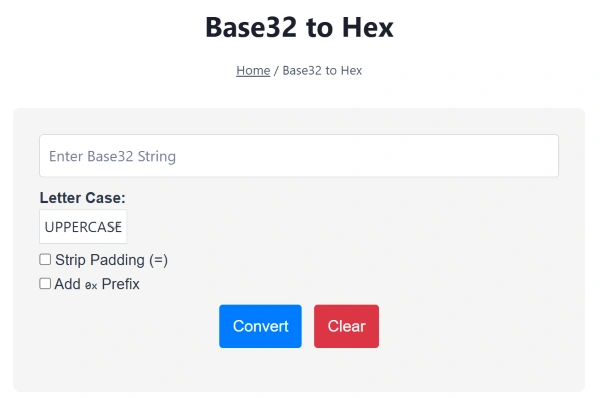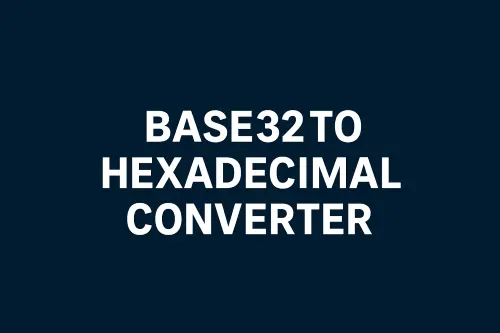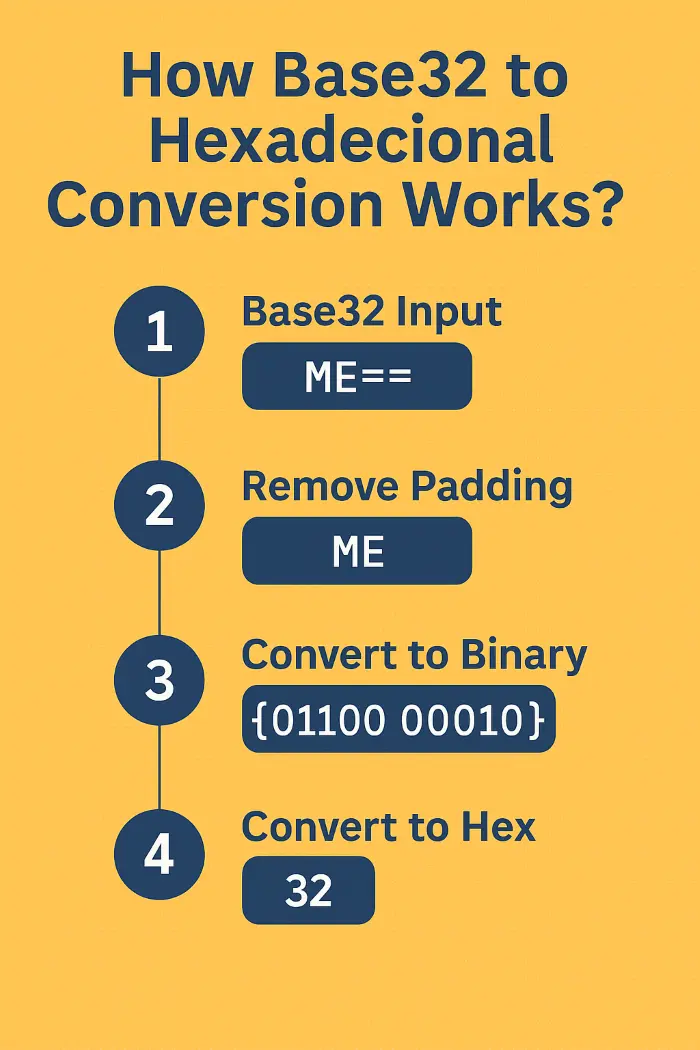Base32 to Hex
Reverse conversion tool: Hex to Base32 converter
Base32 to Hexadecimal Converter – Complete Guide & Online Tool
Converting Base32 encoded data to hexadecimal format is a common requirement in programming, data processing, and system administration. This comprehensive guide explains everything you need to know about Base32 to hex conversion, from fundamental concepts to practical implementation strategies.
The base32 to hex converter image is shown below:

What is Base32 Encoding?
Base32 is a transfer encoding scheme that uses a 32-character alphabet to represent binary data in a human-readable format. The standard Base32 alphabet consists of uppercase letters A through Z and digits 2 through 7, totaling 32 characters. This encoding system is particularly beneficial when dealing with case-insensitive filesystems, spoken communication, or scenarios requiring human memory retention.
Unlike Base64 encoding, Base32 avoids potentially confusing characters like 0 (zero) and O (capital O), or 1 (one) and I (capital I). This makes Base32 ideal for situations where data might be transmitted verbally or transcribed manually.
Understanding Hexadecimal Format
Hexadecimal, or hex, is a base-16 numeral system that uses sixteen distinct symbols: 0-9 and A-F. Each hexadecimal digit represents four binary bits, making it an efficient way to represent binary data in a compact, readable format. Hexadecimal is widely used in computing for memory addresses, color codes in web development, and low-level programming.

Why Convert Base32 to Hex?
Several scenarios require Base32 to hexadecimal conversion:
- Data Processing: When systems expect hexadecimal input but receive Base32 encoded data
- Cryptographic Operations: Converting encoded keys or hashes for cryptographic functions
- System Integration: Bridging different encoding standards between applications
- Debugging: Analyzing encoded data in a more familiar hexadecimal format
- Database Storage: Converting to hex for more efficient database storage and indexing
Base32 to Hex Conversion Methods
Method 1: Direct Character Mapping
The most straightforward approach involves converting Base32 characters to their binary representation, then grouping the bits for hexadecimal conversion. Each Base32 character represents 5 bits of data, while each hex character represents 4 bits.
Method 2: Two-Stage Conversion Process
This method first converts Base32 to decimal, then decimal to hexadecimal. While less efficient for large datasets, it’s easier to understand and implement manually.
Step-by-Step Process:
- Convert each Base32 character to its numeric value
- Calculate the decimal equivalent using positional notation
- Convert the decimal result to hexadecimal format
- Verify the output for accuracy
Method 3: Programming Libraries
Most modern programming languages provide built-in libraries or functions for Base32 to hex conversion. These methods offer better performance and error handling compared to manual implementation.
Practical Conversion Examples

Let’s examine some common Base32 to hex conversion scenarios:
Example 1: Simple Conversion
- Base32 Input:
MFRGG - Binary Representation:
01100 01100 10000 01000 01000 - Hex Output:
62208
Example 2: Padded Base32
- Base32 Input:
MFRGG=== - Processing: Remove padding, convert core data
- Hex Output:
62208
Example 3: Long String Conversion
- Base32 Input:
NBSWY3DPEB3W64TMMQ - Hex Output:
68656c6c6f20776f726c64 - ASCII Equivalent: “hello world”
Base32 Variants and Hex Conversion
Standard Base32 (RFC 4648)
The standard Base32 alphabet uses A-Z and 2-7. When converting to hex, each character maps to specific bit patterns that translate to hexadecimal digits.
Base32hex (Extended Hex Alphabet)
Base32hex uses 0-9 and A-V, providing a different character set that some systems prefer. The conversion process remains similar, but character mapping differs.
Crockford’s Base32
This variant excludes ambiguous characters and includes additional symbols for better human readability. Converting Crockford’s Base32 to hex requires specific character mapping adjustments.
Online Base32 to Hex Tools
When selecting an online converter, consider these essential features:
- Input Validation: Proper handling of invalid characters and formatting
- Padding Support: Automatic detection and processing of Base32 padding
- Batch Processing: Ability to convert multiple values simultaneously
- Output Options: Support for different hex formatting (uppercase, lowercase, prefixes)
- Error Handling: Clear error messages for malformed input
For additional hex operations on your converted results, use our Hex Calculator to perform arithmetic operations, or try our Hex to Decimal Converter for further format transformation.
Programming Implementation
Python Example
import base64
def base32_to_hex(base32_string):
try:
# Decode Base32 to bytes
decoded_bytes = base64.b32decode(base32_string)
# Convert bytes to hex
hex_result = decoded_bytes.hex()
return hex_result.upper()
except Exception as e:
return f"Error: {str(e)}"JavaScript Implementation
function base32ToHex(base32String) {
const base32Chars = 'ABCDEFGHIJKLMNOPQRSTUVWXYZ234567';
let binary = '';
// Convert each Base32 character to 5-bit binary
for (let char of base32String.replace(/=/g, '')) {
const index = base32Chars.indexOf(char.toUpperCase());
if (index === -1) throw new Error('Invalid Base32 character');
binary += index.toString(2).padStart(5, '0');
}
// Convert binary to hex
let hex = '';
for (let i = 0; i < binary.length; i += 4) {
const nibble = binary.substr(i, 4).padEnd(4, '0');
hex += parseInt(nibble, 2).toString(16).toUpperCase();
}
return hex;
}Advanced Conversion Techniques
Handling Large Datasets
For bulk Base32 to hex conversions, consider these optimization strategies:
- Streaming Processing: Process data in chunks rather than loading everything into memory
- Parallel Processing: Utilize multiple CPU cores for concurrent conversions
- Caching: Store frequently converted values to avoid repeated calculations
- Validation Pipeline: Implement multi-stage validation to catch errors early
Error Handling and Validation
Robust Base32 to hex conversion requires comprehensive error handling:
Input Validation:
- Check for invalid Base32 characters
- Verify proper padding format
- Validate string length constraints
- Handle case sensitivity issues
Output Verification:
- Cross-validate results using reverse conversion
- Compare against known test vectors
- Implement checksum verification where applicable
Integration with Related Tools
Your Base32 to hex conversion workflow can be enhanced by integrating with complementary tools:
- Binary to Hex Converter: For intermediate binary processing steps
- Hex to ASCII Converter: To view converted data as readable text
- Base 64 to Hex Converter: For cross-format encoding conversions
- Decimal to Hex Converter: For numeric validation and verification
- Hex to Base 36 Converter: Transform hex to Base 36 conversion
- Hex to Base 36 Converter: Transform Base 36 to hex conversion
- Base 12 to Hex Converter: Transform Base 12 to hex conversion
Common Conversion Challenges
Padding Issues
Base32 encoding uses = characters for padding. When converting to hex, ensure proper padding handling:
- Remove padding before conversion
- Account for incomplete byte boundaries
- Validate final output length
Character Set Confusion
Different Base32 implementations use varying character sets. Always verify which variant you’re working with:
- Standard RFC 4648 Base32
- Base32hex with extended alphabet
- Custom implementations with modified character sets
Case Sensitivity
While Base32 is typically case-insensitive, some implementations are strict about character case. Normalize input strings before conversion to avoid errors.
Performance Optimization
Memory Efficiency
Large Base32 to hex conversions can consume significant memory. Optimize by:
- Processing data in fixed-size chunks
- Using streaming algorithms for continuous data
- Implementing garbage collection strategies
- Monitoring memory usage during bulk operations
Speed Improvements
Enhance conversion speed through:
- Lookup table optimization for character mapping
- Bitwise operations instead of string manipulation
- Compiled language implementations for critical applications
- Hardware acceleration where available
Security Considerations
When implementing Base32 to hex conversion in security-sensitive applications:
Input Sanitization
Always sanitize Base32 input to prevent injection attacks:
- Strip unexpected characters
- Validate input length limits
- Check for malicious patterns
- Implement rate limiting for online tools
Data Protection
Protect sensitive data during conversion:
- Use secure memory allocation
- Clear intermediate variables
- Implement proper logging practices
- Consider encryption for stored conversion results
Troubleshooting Common Issues
Invalid Character Errors
When encountering invalid character errors:
- Verify the Base32 variant being used
- Check for Unicode or special characters
- Validate character case consistency
- Ensure proper string encoding
Length Mismatch Problems
Base32 to hex length mismatches often indicate:
- Incorrect padding handling
- Truncated input strings
- Encoding variant confusion
- Bit boundary alignment issues
Output Validation Failures
If converted hex output seems incorrect:
- Perform reverse conversion for verification
- Compare against known test cases
- Check intermediate conversion steps
- Validate using multiple conversion tools
For advanced hex operations on your results, utilize our Hex Calc to perform arithmetic operations.
Best Practices for Base32 to Hex Conversion
Production Implementation
- Implement comprehensive error handling
- Use established, well-tested libraries
- Perform thorough input validation
- Include extensive unit test coverage
- Document expected input/output formats
Performance Monitoring
- Track conversion times for performance optimization
- Monitor memory usage during bulk operations
- Log conversion errors for analysis
- Implement alerting for unusual patterns
Maintenance Considerations
- Regular testing with new data sets
- Updates for changing encoding standards
- Performance benchmarking and optimization
- Security audit and vulnerability assessment
Testing and Validation
Test Vector Verification
Use these standard test vectors to verify your Base32 to hex conversion implementation:
- Empty string:
""→"" - Single character:
"MY"→"66" - Common phrase:
"MFRGG"→"62208" - With padding:
"MFRGG==="→"62208"
Cross-Platform Testing
Ensure consistent results across different:
- Operating systems
- Programming languages
- Library implementations
- Character encodings
Related Conversion Tools
Expand your number system conversion capabilities with these related tools:
- Hex to Binary Converter: Convert hexadecimal results to binary format
- ASCII to Hex Converter: Transform text data to hexadecimal
- Hex to Base 64 Converter: Convert hex to web-safe Base64 encoding
- Octal to Hex Converter: Bridge octal and hexadecimal number systems
- IP to Hex Converter: Convert network addresses to hex format
FAQs About Base32 to Hex Converter
Q1: How can Base32 to hex conversion be automated for enterprise projects?
A1: Organizations often tie conversion routines into data pipelines or automation scripts, allowing seed or credential data to smoothly transition between platforms. Scripting solutions—like PowerShell for bulk file transformations—are common in managing large-scale migrations or token management.
Q2: What steps help when migrating seed data between authentication systems?
A2: When switching security platforms, confirm the expected input format for the destination system. Automated converters and scripts can quickly transform Base32-encoded data to hex and vice versa, eliminating manual re-entry errors and ensuring compatibility for authentication factors.
Q3: Which libraries are best for large-scale Base32 to hex conversions?
A3: For stability and ease of maintenance, choose established libraries or community-supported utilities in your preferred programming environment. This minimizes unforeseen errors, especially important when processing data in large batches or integrating with legacy software.
Q4: What are common challenges when managing cross-platform Base32/hex workflows?
A4: Troubleshooting often involves handling character set differences (such as custom Base32 alphabets), correcting for padding issues, and preventing encoding mismatches. Reliable validation—such as comparing outputs with known test vectors—ensures accurate, reproducible results across varied systems.
Q5: How does Base32 to hex conversion strengthen security in token management?
A5: Converting seeds and cryptographic secrets between formats makes it easier to standardize credential storage, apply encryption consistently, and verify hash integrity across distributed authentication or SSO environments.
Q6: What strategies help with troubleshooting conversion errors?
A6: Effective troubleshooting includes confirming the encoding variant in use, relying on automated scripts with error logging, normalizing input to prevent typographical mistakes, and double-checking results against alternative trusted tools.
Q7: What real-world scenarios require custom Base32/hex solutions?
A7: Organizations may need robust batch-processing tools to migrate hardware token secrets, update credential files, or sync legacy data with new authentication platforms. In these cases, custom converters and integration scripts support operational continuity and data integrity.
